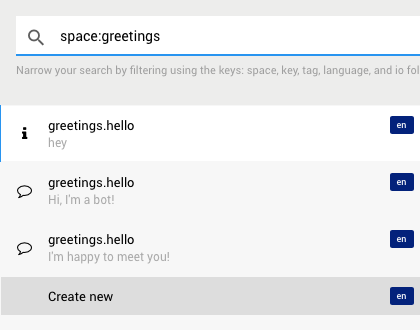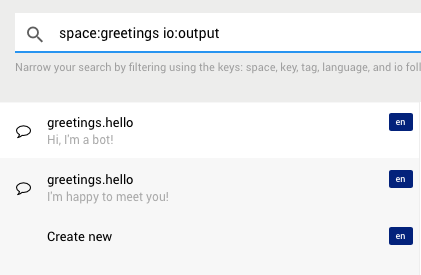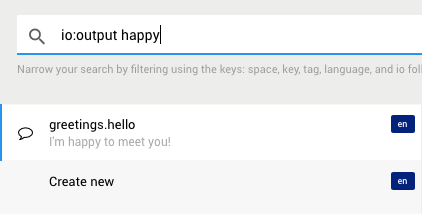CMS entity editor
How to create, edit, delete, filter and search for content
The CMS Entity Editor is where you manage the content in your spaces.
Searching for content in Bot CMS
At the top of the Entity Editor you’ll find a search bar. You can search for text that appears in the Value field of an entity. You can filter results by using the terms: space, key, tag, language, and io, separately or together.
Here are some examples:
<empty search>

An empty search returns all entities.
space:greetings

You can filter entities by space.
space:greetings io:output

You can filter entities by multiple attributes.
io:output happy

You can use filters and search terms.
Adding a new entity
An entity is a unit of content. It could be a phrase you expect the user to say, or some information you want your bot to display to the user.
Add a new entity by clicking the New button in the bottom right corner of the Entity Editor. The Space field may be pre-populated with the name of the space you are currently in, but you can add content to other spaces by changing this field. If the space doesn’t exist, it will be created when you save the entity.
Unsaved entitiesYou can create new entities without saving by clicking the New button. Unsaved entities appear with a small dot after their name in the entity list on the left side of the Entity Editor.
It is highly recommended that you use the Save each entity before creating a new one; you can always come back and edit or delete entities later.

An unsaved entity has a dot to the right of its name.
If you think of a space as a dictionary, the word you’re looking up would be the key, and the definition would be the value. You can assign multiple entities the same key. For example, you might have several entities with a key of hello, each containing a different form of greeting in the Value field. You might want to do this if you're training an Natural Language Understanding agent to understand multiple greetings, or if you want your bot to respond with a randomly selected greeting.
The Language field will be pre-populated with your bot’s default language.
Default languageYour bot’s default language can be set by clicking Settings from within your bot’s dashboard and updating the Default Language field.
The IO Type informs your bot as to whether this is content it can display, or is content it should expect the user to submit.
The Tag field allows you to set a tag an analytics platform (e.g. Segment, Google Analytics can examine. You could use this feature to A/B test content, for example.
Required or optional?The Space, Key, Value, Language, and IO Type fields are all required; only the Tag field is optional.
Once the required fields have been filled out, click Save. Your new entity should appear in the list of entities on the left side of the Entity Editor.
Leaving the Entity Editor
Click Close to exit the Entity Editor.
Unsaved content will be lost!Any content in the Entity Editor that hasn’t been saved will be lost, so don’t forget to save your entities!
Entity Editor tips
Keep these time-saving tips in mind when you're editing your content:
-
If you use the Save & Next shortcut shown at the bottom of the Entity Editor, a new entity will be generated with most of the fields pre-populated. This can be a big time saver when entering a large number of entities.
-
You don’t need to exit the Entity Editor and go into another space to edit the content in that space. You can add, delete, and edit content from any space using the Entity Editor.
Updated 7 months ago
